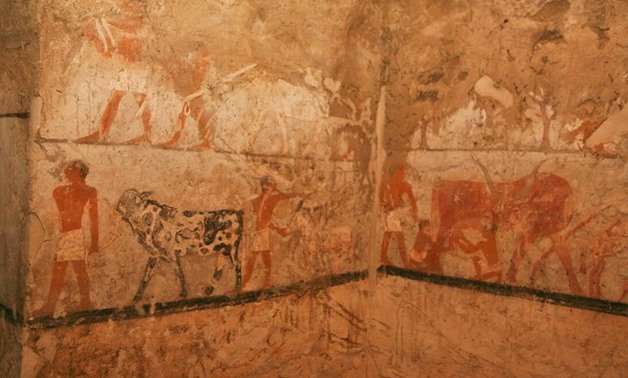
Painting throughout the walls of Hetpet's tomb – photo courtesy of Ministry of Antiquities
CAIRO – 5 February 2018: In light of unveiling information about the recently excavated ancient Egyptian 4,400 years old tomb of a lady called “Hetpet”, the Ministry of antiquities describes the secrets of the tomb in a press release on Monday.
A senior official at the royal palace during the end of the fifth Dynasty, Hetpet was buried in a tomb that was recently discovered at a western cemetery located in Giza earlier last week by an Egyptian archeological mission led by the Secretary General of the Supreme Council of Antiquities Mostafa El Waziri.
.jpg) Painting throughout the walls of Hetpet's tomb – photo courtesy of Ministry of Antiquities
Painting throughout the walls of Hetpet's tomb – photo courtesy of Ministry of Antiquities
1- The tomb speaks about the Fifth Dynasty
Hetpet was buried in a tomb featuring several architectural styles and decorative elements that were common among burial chambers and tombs of the fifth Dynasty. Beyond the entrance of the tomb, an “L” shape shrine with purification basin is found where at its western rare end a rectangular arcade is found lining with incense.
2-Hetpet a passionate mother in heart, a dominant icon in society
A priestess to the goddess of fertility Hathor who was known for helping women during birth, Hetpet is portrayed in some of the paintings throughout the tomb standing in different scenarios in her life where she is hunting, fishing, or sitting with her children on a large table.
 a painting of Hetpet sitting on a table as her children provide her offerings
a painting of Hetpet sitting on a table as her children provide her offerings
Hathor is depicted on the walls as a cow however stands as a strong symbol of motherhood and love which links to Hetpet where she is painting on the walls sitting with her children on a large table engaging in a conversation and receiving offerings from them. A prestigious icon in society at the time, Hetpet had strong connections with many members of the royal family.
 Minister of Antiquities Khaled El Anani overlooking tomb – photo courtesy of Ministry of Antiquities
Minister of Antiquities Khaled El Anani overlooking tomb – photo courtesy of Ministry of Antiquities
3-The tomb’s paintings speak 1,000 words
Hetpet’s tomb significantly features vivid paintings of her life and other scenarios of the fifth dynasty including one painting featuring people reaping fruits, working in creating metals and fabrication of leather and papyri boats, and enjoying entertaining nights that included musicals and dancing performances.
 Painting throughout the walls of Hetpet's tomb – photo courtesy of Ministry of Antiquities
Painting throughout the walls of Hetpet's tomb – photo courtesy of Ministry of Antiquities
Other paintings include one featuring two monkeys sitting in different positions, one eating fruits while the other is dancing in front of an orchestra. Monkeys at the time were not only raised as a pet but also as a guard to its owner.
Other tombs have featured similar paintings including one painted on the wall of a tomb dating back to the 12th Dynasty of “Khanoum Hetep II” that was excavated in Minya governorate; while another similar painting was found in a tomb dating back to the Old Kingdom, depicting a monkey dancing in front of a guitarist.
Giza western cemetery is known for housing tombs of senior officials of the Old Kingdom that have been discovered since 1842.
 Paintings throughout the wall - Photo courtesy of Ministry of Antiquities
Paintings throughout the wall - Photo courtesy of Ministry of Antiquities
.jpg)




Comments
Leave a Comment